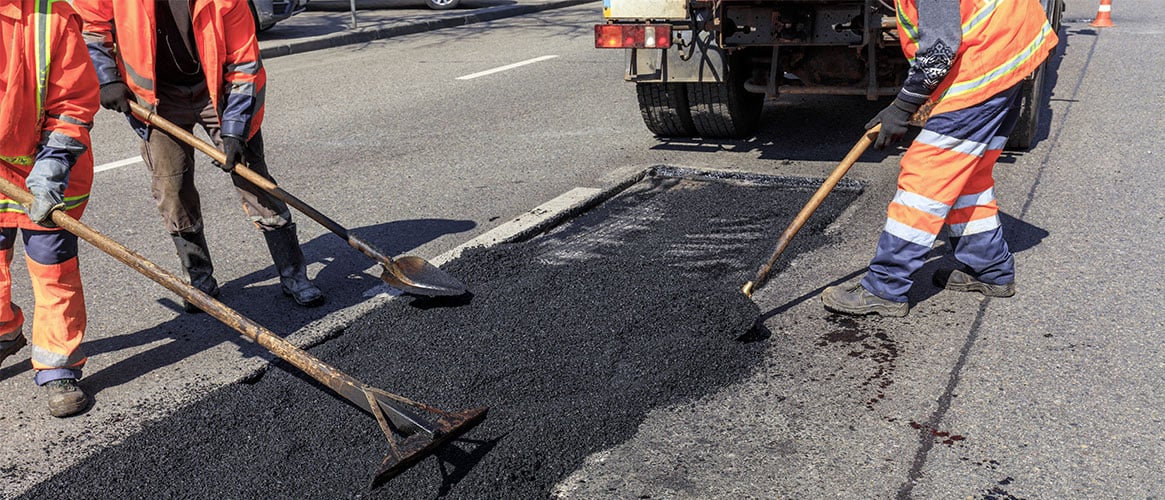Asphalt is used for roofing, concrete work, and paving and surfacing roads. It is made from petroleum products and is heated between 250-400 degrees Fahrenheit. Asphalt can be mixed with solvents (diesel, kerosene, naphtha, toluene, and xylene), binders, hardening, and bonding agents (resins), crushed rock, sand, and recycled rubber. Exposure to asphalt fumes can lead to burns as well as skin and eye irritation. It can also lead to long-term health problems such as allergies, lung irritation, and cancer.
What your employees need to know about working with asphalt
Breathing asphalt fumes is the most common method of exposure. The acute (immediate) health effects of asphalt fumes include headache, skin rash, fatigue, eye and throat irritation, and cough. Exposure also puts workers at risk of cancer to the lungs and other parts of the body. To find out the specific hazards associated with the type of asphalt you are working with, consult the Safety Data Sheet (SDS) from your employer.
Many forms of asphalt are flammable. This can lead to potential fires and explosions. Sources of ignition (sparks, flames, cigarettes, etc.) should be kept away from the area where the asphalt is being used. Asphalt is almost always used hot, so burns are a common form of injuries. Have a fire extinguisher available, rated type B or ABC for possible fires. Do not use a fire extinguisher unless you have been fully trained in its use.
What your employees need to do when working with asphalt
Use the appropriate personal protective equipment (PPE). Thermally insulated gloves prevent asphalt burns and stop solvents from soaking into your skin. Long sleeves and long pants or coveralls protect the arms and legs. Safety glasses and a face shield protect your eyes and face. Safety boots protect your feet. If necessary, use respiratory protection to prevent overexposure to asphalt fumes.
In addition to PPE, these control measures can help minimize the risk:
- Substitution: There are many types of asphalt. Some are more hazardous than others. If possible, substitute a less hazardous form of asphalt in your construction project—such as asphalt with lower levels of benzyne or diesel.
- Isolation: Isolate the asphalt operations to minimize worker exposure. Where possible, transfer the asphalt automatically by pump to help workers avoid breathing in fumes and vapors, and to avoid coming in contact with the hot asphalt.
- Enclosure: Enclose the mixing and stirring operations. Stirring asphalt in an open kettle exposes your employees to fumes, solvent vapors, and possible burns. A lid with an exhaust pipe that extends upward and out of your employees’ breathing space is one enclosure example.
What to cover at your safety meeting about working with asphalt
Take the time to review and explain your SDS. These contain important information about hazardous materials to help your employees avoid injury and illness. These include what the hazardous material is, the safety risk it presents, and the safety steps employees need to take.
Other things to cover include:
- Personal protective equipment (PPE). Demonstrate how to properly use the PPE required for the job. Refer to the SDS for the correct PPE and ensure it holds up to the temperature of the asphalt. Refer to the PPE instruction manual for proper use.
- Substitution, isolation, and enclosure. Describe methods and tools that will help distance workers from harmful fumes.
- Emergency response procedures. Review your procedures so everyone knows what to do in case someone is overcome by fumes or suffers burns. This includes how to contact emergency response and whether First Aid and CPR is required.
Those who work with asphalt provide a valuable service to all of us—especially when it comes to road repairs or installing roofing. Keep your employees safe on the job by protecting them from the heat and fumes that asphalt produces.

